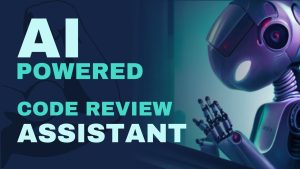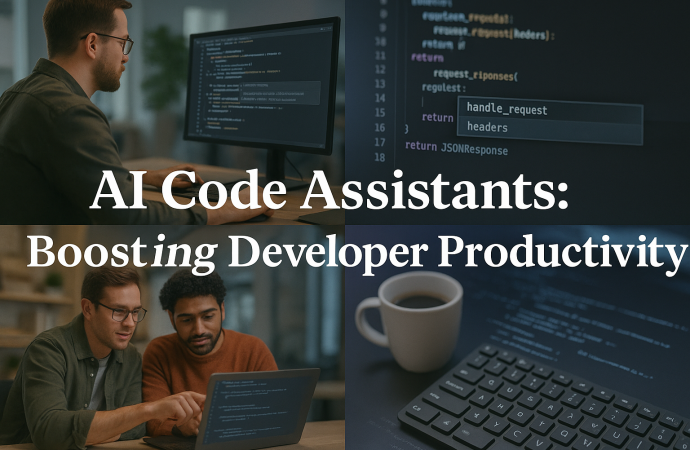Introduction Writing code is both creative and repetitive. Developers sketch out new features, then labor through boilerplate, tests, and documentation. In 2025, AI code assistants help balance these tasks. By suggesting snippets, detecting bugs early, and automating routine steps, AI tools free developers to focus on core logic and innovation. These assistants integrate into editors,
Introduction
Writing code is both creative and repetitive. Developers sketch out new features, then labor through boilerplate, tests, and documentation. In 2025, AI code assistants help balance these tasks. By suggesting snippets, detecting bugs early, and automating routine steps, AI tools free developers to focus on core logic and innovation. These assistants integrate into editors, pull request workflows, and continuous integration pipelines. The result? Faster delivery, fewer errors, and happier teams. In this article, we explore what AI code assistants are, how they work, their benefits for developer productivity, best practices for adoption, challenges, and a look to the future. We’ll also compare leading tools in a handy table. By the end, you’ll see why AI code assistance is now essential for any modern software team.
What Is an AI Code Assistant?
AI code assistants are software tools that use artificial intelligence to help developers write, review, and maintain code. They learn from vast codebases and documentation to suggest lines of code, flag potential issues, and even generate tests. Unlike simple autocomplete, these assistants understand context, variable names, and code patterns. They can answer questions about APIs, convert comments into code, and refactor methods on demand. With AI models trained on public repositories and internal code, they adapt to team conventions and project needs. By bringing intelligence into the developer’s workflow, AI code assistants bridge the gap between idea and implementation.
Evolution of AI in Development
Early code editors offered basic autocomplete based on local symbols. Over time, plugins added linting and static analysis. The real leap came with large language models capable of generating coherent code from natural language prompts. Tools like GitHub Copilot and Amazon CodeWhisperer pioneered this space in the early 2020s. By 2025, AI models are more accurate and integrate deeply with IDEs, version control systems, and build tools. They learn continuously from pull requests and code reviews, improving suggestions over time.
How AI Code Assistants Work

Image by: Yandex.com
AI code assistants rely on machine learning models trained on massive datasets of code. These models use transformer architectures to predict the next token or line based on surrounding context.
Natural Language Prompts
Developers type comments or natural language queries like “Create a function to merge two sorted arrays.” The assistant parses the request and generates code that matches the prompt. This lowers the barrier for junior developers and speeds prototyping.
Contextual Code Completion
As you type, the assistant suggests entire lines or blocks that fit current variables, functions, and modules. It looks at file imports, function signatures, and naming conventions to produce accurate suggestions. Accepting a suggestion inserts the code directly, saving keystrokes.
Automated Testing and Documentation
Some AI code assistants generate unit tests based on existing code behavior. They can propose docstrings that summarize method purpose and parameters. This automation improves code quality and standardization without extra manual work.
Continuous Learning from Feedback
When developers accept, reject, or modify suggestions, the AI learns from these actions. Over time, the assistant aligns more closely with team style guides and reduces irrelevant proposals. Feedback loops ensure that productivity gains compound.
Benefits for Developer Productivity

Image by: Yandex.com
Integrating AI code assistants yields clear advantages for software teams.
Speeding Up Routine Tasks
By handling boilerplate code and standard patterns, AI assistants cut down time spent on repetitive tasks. Generating CRUD operations, API clients, or configuration files becomes a few-keypress job.
Reducing Bugs Early
Contextual analysis catches potential errors as you type. Missing imports, type mismatches, and unused variables are flagged immediately. Early feedback prevents bugs from progressing to later stages of development, saving debugging effort.
Enhancing Onboarding
New team members often struggle to learn codebase conventions. AI suggestions reflect current patterns, helping juniors write code that aligns with project standards. This guidance accelerates ramp-up time and reduces code review cycles.
Boosting Code Consistency
When multiple developers follow AI-generated patterns, code style and structure become more uniform. Standardized test suites and documentation further reinforce consistency, easing maintenance and collaboration.
Encouraging Experimentation
With AI handling repetitive parts, developers can experiment with new architectures or libraries without fearing the cost of manual setup. Prototypes and proof-of-concepts emerge faster, fostering innovation.
Best Practices for Adopting AI Code Assistants

Image by: Yandex.com
To maximize benefits while avoiding pitfalls, follow these guidelines.
Choose the Right Tool for Your Stack
Evaluate AI assistants that support your primary languages and frameworks. Check integration with your IDE—whether VS Code, IntelliJ, or another editor—and compatibility with build tools and CI pipelines.
Provide Clear Prompts
Effective natural language prompts yield better code. Instead of “function for user,” specify “function to validate user email format using regex and return boolean.” Clear instructions help AI generate precise code.
Review Suggestions Carefully
AI can produce incorrect or insecure code. Always review and test generated code before merging. Use code reviews as teaching moments to refine team understanding and AI alignment.
Integrate with CI/CD
Configure your continuous integration pipelines to run AI-generated tests and linters. This ensures automated checks for suggestion quality and prevents errors from reaching production.
Track Metrics and Feedback
Monitor metrics such as suggestion acceptance rates, reduction in bugs, and time saved on routine tasks. Gather developer feedback to adjust AI settings and prompt templates over time.
Challenges and How to Overcome Them

Image by: Yandex.com
AI code assistants also present challenges that teams must address.
Security and Privacy Concerns
Using public AI models may risk exposing proprietary code. Some assistants share data with external servers.
Solution: Opt for on-premises or private cloud deployments. Choose vendors that guarantee data isolation and comply with regulations like GDPR.
Licensing and Attribution
AI models trained on public code may reproduce snippets under various open-source licenses. This can raise compliance issues.
Solution: Use tools that track code provenance. Implement checks for license compatibility and train developers to modify generated code sufficiently to avoid direct copying.
Bias and Quality Variance
AI suggestions reflect the training data. If the data contains insecure patterns or outdated styles, recommendations may be suboptimal.
Solution: Continuously retrain models on your codebase and style guides. Curate training data to emphasize best practices and up-to-date patterns.
Overreliance on AI
Developers may become too dependent on AI, losing problem-solving skills.
Solution: Encourage regular hands-on coding without AI assistance. Use AI as a helper, not a crutch, and reserve challenging tasks for manual implementation.
The Future of AI Code Assistance

Image by: Yandex.com
AI code assistants will become more capable and integrated.
Deeper Context Awareness
Future models will understand entire projects, not just open files. They will suggest improvements across modules and flag architectural issues.
Multimodal Code Generation
Developers may describe UI designs via sketches or voice commands. AI will translate these inputs into front-end code or prototypes.
Automated Security and Compliance
AI will suggest security patches and license checks in real time. It may auto-generate compliant code snippets that adhere to corporate policies and industry standards.
Collaborative AI Pair Programming
AI will join team coding sessions as a virtual pair programmer. It will speak suggestions, highlight code smells, and even join video calls to explain logic.
Conclusion
AI code assistants are reshaping software development by automating routine tasks, improving code quality, and speeding up onboarding. By understanding how these tools work—through natural language prompts, contextual suggestions, and integrated testing—teams can boost developer productivity and consistency. Adopting AI code assistants requires clear prompts, careful review, and attention to privacy and licensing. Leading tools like GitHub Copilot, Amazon CodeWhisperer, and Tabnine offer diverse features and deployment options. As AI models become more context-aware and multimodal, they will serve as true coding partners. Embracing AI code assistance today sets the stage for faster innovation and higher-quality software in 2025 and beyond.
Call-to-Action: Ready to supercharge your development workflow? Try an AI code assistant free trial today and see how smart coding suggestions can transform your productivity!
















